Texas Hold’em Rules: Learn How to Play Texas Hold’em
 Reviewed by Chris ‘Fox’ Wallace
Reviewed by Chris ‘Fox’ Wallace
Texas Hold’em is the most popular poker game in the world, both live and online. Whether you’ve watched friends play for matchsticks around the kitchen table, or stars compete for millions of dollars on TV, the chances are that they were all playing Texas Hold’em.
Want to take part yourself? Then good news – it’s an easy game to learn!
How To Play Texas Hold ’em – Video Tutorial
Check out the video below, and read on for everything you need to know about Texas Hold’em hands, rules, how to play, how to bet and even some strategies to use when you start playing Texas Hold’em online.
Texas Hold’em is so popular for many reasons. The game mixes skill & luck in a very engaging way. There is also an element of risk as well as some math involved. Poker is a great all round game for all skill levels!
Play Texas Hold’em for free at our no-risk practice tables! No downloads, deposits or accounts needed.
What Is Texas Hold’em?
Texas Hold’em poker sees players attempt to make the best poker hand they can out of seven cards – two of which can be seen only by them. As five cards are shared between all players (the ‘community cards’ or ‘the board’), everyone has some idea of what the other players may have.
Need a reminder of what beats what? Just check out our guide to all the different poker hands.
Here are the basics:
- Texas Hold’em uses a standard deck of 52 playing cards.
- Each player is dealt two cards, one at a time, face down. These are known as ‘hole cards’, ‘down cards’, or ‘pocket cards’.
- There is an initial betting round. Three community cards are then dealt in the middle of the table, face up. These are known collectively as ‘the flop’, and all players may use these cards to make their best five-card hand.
- This is followed by the second round of betting. A fourth community card is then dealt face up. Known as ‘the turn’, this is followed by a third betting round.
- A fifth and final community card is dealt, known as ‘the river’. The final round of betting follows.
- The pot is awarded to the player who has the best five-card poker hand, or to the last player remaining who hasn’t folded.
Players may use any combination of community cards and their own hole cards to make the strongest hand, as illustrated in our guide to poker hands.
How Betting Works in Texas Hold’em
Almost all poker games feature betting rounds and they tend to all follow the same patterns, so these rules can be applied to most poker games you’ll come across.
- Betting moves clockwise around the table, usually starting with the player to the left of the ‘Dealer’ button.
- If there is no bet to call, players may ‘check’ (i.e. bet nothing) or bet any amount of chips they wish (as long as it is more than a big blind – see below).
- If a bet has been made, players may ‘fold’ (discard their hand and wait for the next deal), ‘call’ (match the amount of chips that have been wagered), or ‘raise’ (increase the size of the bet, which any original bettors or callers would then have to call).
- If any chips have been bet, all players must match that amount of chips (or ‘call’) to stay in the hand.
- If a player doesn’t have enough chips to call a bet, they may instead put in all their remaining chips (although they will only be eligible to win that amount of chips from each player).
- A raise must be at least equal to the amount originally bet, so to raise a bet of $5 you must raise it by at least another $5.
- Texas Hold’em is mostly played as a no-limit game, which means any player can bet all they have when it is their turn to act. A Limit Hold’em game is one where all bets are in pre-set units, while a pot-limit game restricts the size of any raise to the size of the pot (see our Pot-Limit Omaha page for a more detailed explanation).
This table shows how the betting differs in typical Limit and No-Limit Hold’em ring games, even if they both have the same buy-in.
First 2 Betting Rounds
| Game | Standard Buy-in | Small Blind | Big Blind | Minimum Bet | Maximum Bet |
|---|---|---|---|---|---|
| Limit Hold’em | $100 | $0.50 | $1 | $1 | $1 |
| No-Limit Hold’em | $100 | $0.50 | $1 | $1 | uncapped |
Last 2 Betting Rounds
| Game | Standard Buy-in | Small Blind | Big Blind | Minimum Bet | Maximum Bet |
|---|---|---|---|---|---|
| Limit Hold’em | $100 | $0.50 | $1 | $2 | $2 |
| No-Limit Hold’em | $100 | $0.50 | $1 | $1 | uncapped |
Ready to play? Compare the best Texas Hold’em poker sites first.
What are ‘Blinds’ and ‘the Button’ in Poker?
Texas Hold’em uses ‘blinds’, or forced bets, to get the betting moving from the very start of each hand.
When players first receive their cards, the player to the immediate left of the ‘button’ (also known as the Dealer position, last to act in most betting rounds) is obliged to put in a small bet, known as the ‘small blind’. The next player to them, clockwise, must put in a larger bet, the ‘big blind’, around double the size of the small blind.
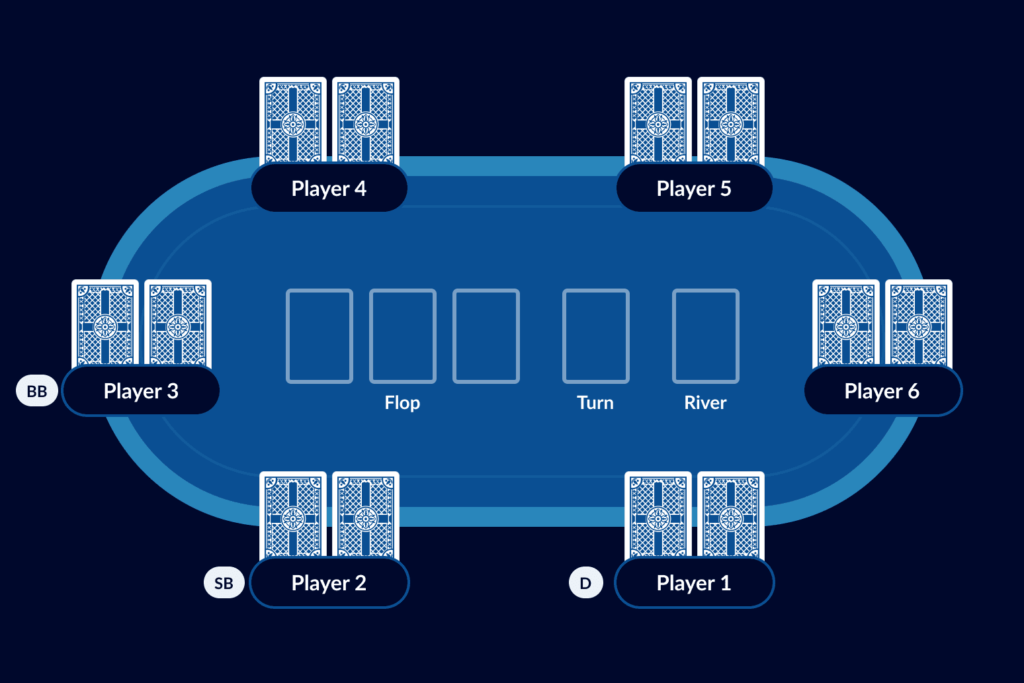
These forced bets create an incentive for players to bet – so they can win the chips in the middle. It also means the next player is already facing a bet, and so must either call, raise or fold – no staying in for free!
If a player raises in this first betting round, all other players must match their bet. If no one raises, when the action moves around to the small blind they must ‘complete their blind’ by adding chips until they have put in the full amount of the big blind.
In this instance, the big blind can check (having already put in the same amount as every other player still in), but also has the option to raise if they wish.
The position of the button moves one place clockwise at the end of every deal, so every player pays the small and big blinds roughly the same amount of times.
When only two players are seated, the button is the small blind and first to act after the deal, but acts last on every round after that.
Texas Hold’em Rules – A Step by Step Guide
Let’s take a closer look at how a Texas Hold’em hand is played, from start to finish.
1. The Deal
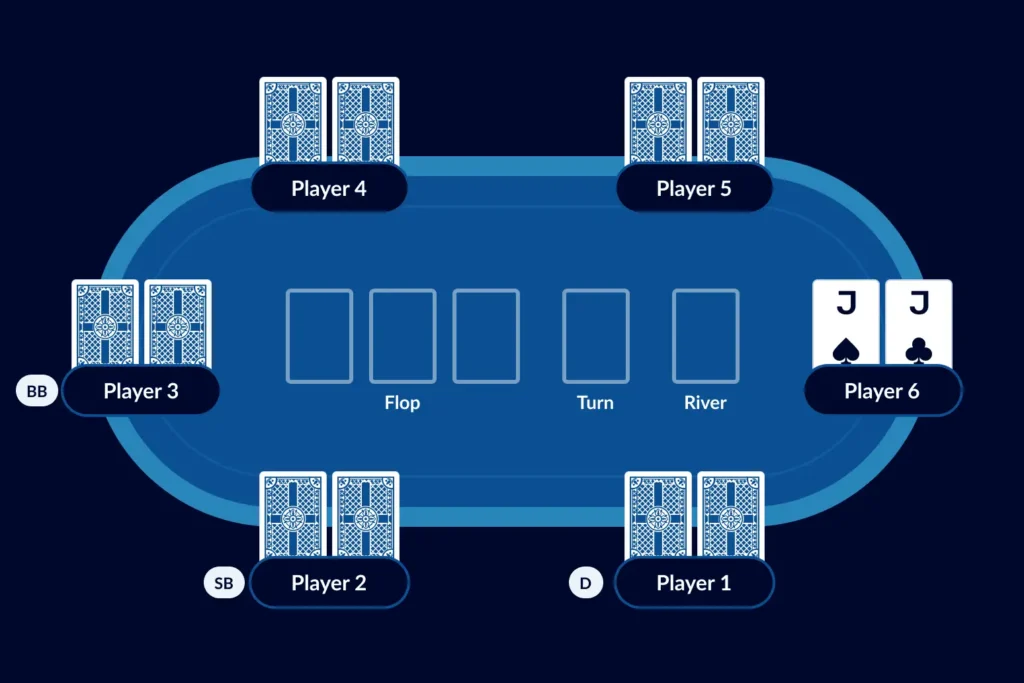
This hand is from a $1/$2 no-limit cash game, meaning the small blind is $1 and the big blind is $2. In a game of this size, players would usually buy in for anything from $50-$200, but much larger stacks are possible if the game has been running for a while.
We can see that Player 1 is the dealer, as they have the button, making Players 2 and 3 the small and big blinds, respectively.
In late position, one player has been dealt a pair of jacks – a strong starting hand. When the action reaches them, they make a good-sized bet to ‘protect their hand’ (i.e. making it too expensive for weak or prospective hands to stay in the hand) and raise to $10. The button and both blinds call.
2. The Flop
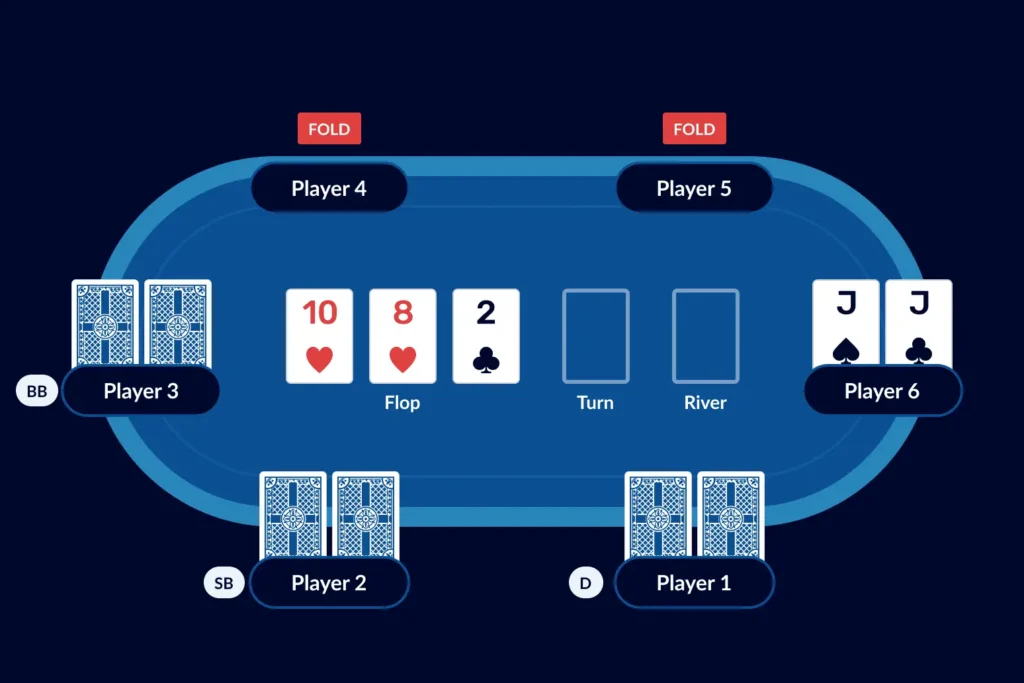
With preflop betting complete, three communal cards – ‘the flop’ – are spread in the center of the table for all players to use.
In this case, the cards do not improve Player 6’s hand, but with no cards higher than their pair on the board (they have what is known as an ‘overpair’) they still feel confident that they have the best hand. Players 2 and 3 both check, and Player 6 bets out again with a $20 bet. Players 1 and 2 both call.
3. The Turn
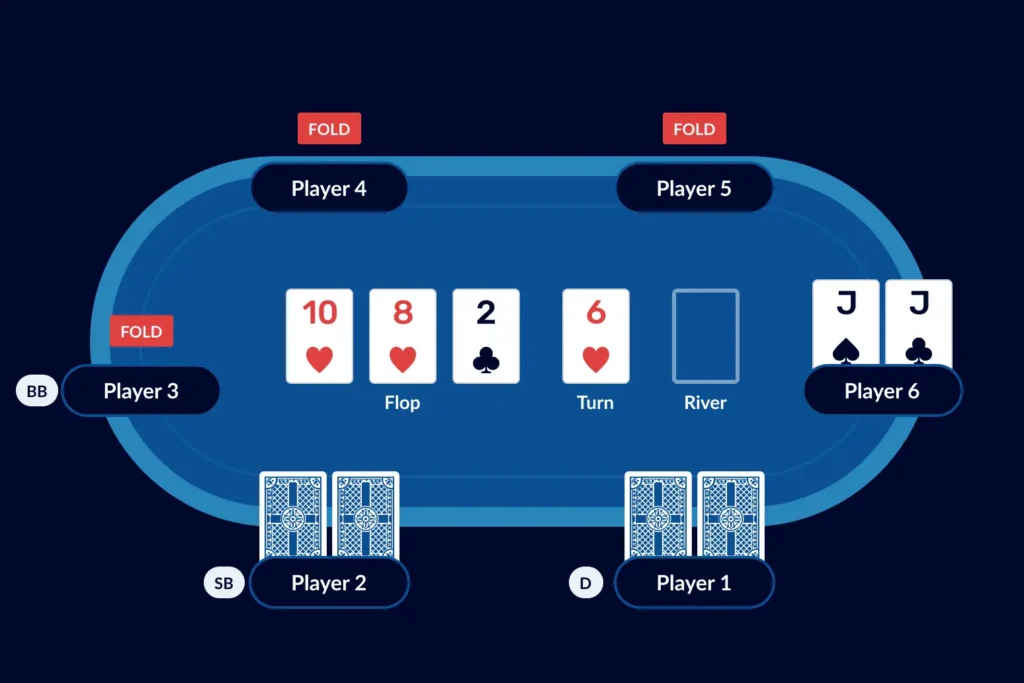
A fourth communal card – ‘the turn’ – is dealt, and has brought a third heart to the board. This means that a flush is now a possibility, as anyone with two hearts as their hole cards could use them with the three on the board for five hearts (aka a flush).
Player 2, first to act as they are the first active player to the dealer’s left, checks. Player 6 is concerned by the possible flush, but feels they may still have the best hand – what’s more, if they check and a fourth heart is dealt on the river, their opponent will just need a single heart in their hand to make a flush, so they don’t want to give an opponent the chance to catch a good card for free.
They follow up their bet on the flop with a larger bet on the turn, putting in $50. Player 1 folds, and Player 2 calls.
4. The River
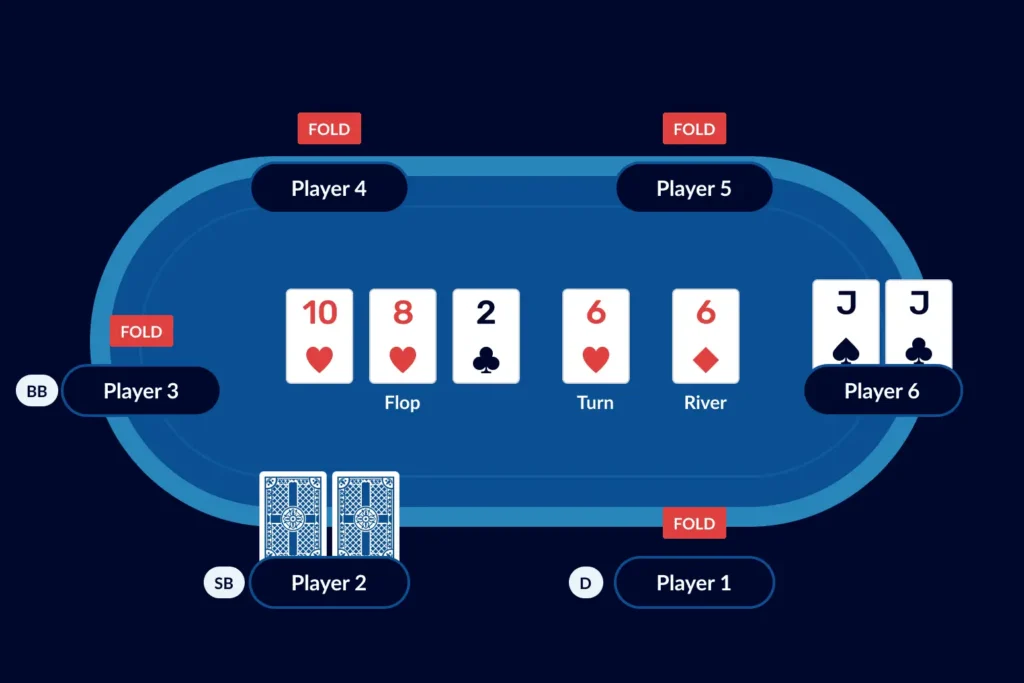
The final community card, known as ‘the river’, is dealt. Any remaining players now have seven cards from which to make their strongest five-card poker hand, and the final betting round ensues.
In this case the river is another six, and Player 2 makes a large bet of $100. Player 6 now has to decide whether to fold, call or raise this bet.
Let’s look at what Player 2 could be holding which would beat Player 6’s pair of jacks. A third six in their hand would make three-of-a-kind; a 7-9 combo would give them a straight; if they held any two hearts they’d have a flush; a pair of tens, eights or deuces in their hand would give them a full house; while a pair of queens, kings or aces would be a higher pair than jacks and also win the pot.
Player 6 now has some thinking to do: would Player 2 have played the hand the way they did, had they been holding any of those card combinations? Would they have called the bets they did with a worse hand than jacks? Are they the type of player who would attempt a bluff in this situation?
Player 6 decides to make the call. Would you?
5. The Showdown
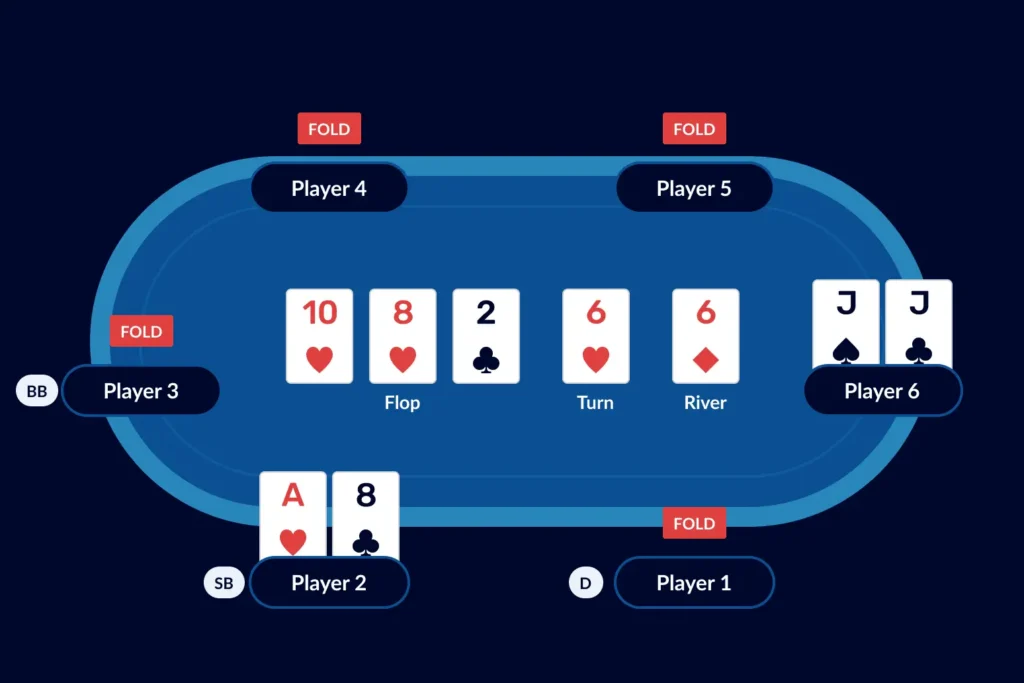
With the final betting round complete, both players reveal their hole cards and the strongest hand wins the pot.
Player 2 shows A 8
, and we can see that they made a pair on the flop, which became a flush draw when the fourth heart arrived on the turn. When the flush failed to materialize on the river, they made a big bet hoping their opponent would fold. In other words, they bluffed.
But this time it didn’t work, as Player 6 felt their overpair was strong enough to call the bet and have a good chance of winning.
The pot gets pushed to Player 6, the dealer button moves one spot to the left, and a new hand is dealt.
Ready to put your new skills to the test? Compare the best Texas Hold’em poker sites first.
Try more poker games!
If you enjoy Texas Hold’em, you’ll love the game of Omaha. Check out the rules to this and other games in our top 10 poker games section. Or if you think you’re ready to start playing poker online, then check out our best real money Texas Hold’em poker sites.
Texas Hold’em Rules FAQ
Is Texas Hold’em easy to learn?
The basic rules of Texas Hold’em are quite simple. If you’ve played any poker at all, you’re already familiar with hand ranks and standard betting options like bet, check, call, fold, and raise. From there it’s simply a matter of remembering the two forced bets (small blind, big blind) and four betting rounds (pre-flop, the flop, the turn, and the river).
Beyond the basics, it’s a matter of how scientific you want to be by learning how to count outs, and from there calculating card odds and pot odds. These indicators help you decide which betting options to exercise on each street.
Can I practice Texas Hold’em Poker online for free?
Absolutely – you can play online for free at our exclusive CardsChat tables, against real players, with no downloads, deposits or registration required. Top sites also offer free play options where you can gain experience and improve your Texas Hold’em Poker skills for free.
How does Poker Texas Hold’em differ from other poker variations?
The differences between Texas Hold’em and other ‘high hand wins’ poker variations include:
- The numbers and names of betting rounds
- How many community cards are dealt
- The number of hole cards dealt
Is Texas Hold’em easier than other variations?
Once you understand the betting round structure, Texas Hold’em is one of the most straightforward poker variations you can find.
What makes Texas Hold’em so popular?
Texas Hold’em poker has an attractive betting round structure with catchy, colorful nicknames. Beyond that, the combination of televised poker tournaments featuring hole cards cameras and the viral nature of Internet word-of-mouth rocketed Texas Hold’em to prominence.
Is there a limit to the number of players in Texas Hold’em?
It depends on how many burn cards there are in the deal. There are usually three, which including the five community cards leaves 44 cards for player hole cards. Since each player receives two cards, the theoretical limit per deck is 22 players.
However, a comfortable full table is typically 9 or 10 players.
Is there a minimum number of players needed?
At least two players are needed, otherwise there’s no possibility of winning someone else’s chips!
Does Texas Hold’em offer better winning opportunities?
In general, winning opportunities in poker are proportional to the number of betting rounds. Since Texas Hold’em has four streets, it has more winning opportunities than variants with less than four streets, and less winning opportunities than variants with more.
How do I know whether to bet or fold?
People have varying accuracies of “gut-feel”. But the only way to get scientific about betting is to do the math. That means diligently counting outs, and calculating and comparing card odds and pot odds.
Card odds indicate your chances of receiving an out card that makes your hand a winner. Pot odds indicate the value of the pot relative to how much you must bet to win it. When card odds are equal to or better than pot odds, it’s reasonable to stay. Otherwise, it’s more reasonable to fold.
Scientific players will beat pure gut-feel players in the long run. Poker Odds for Dummies and Poker Strategy are great guides to poker odds and Texas Hold’em strategy. Also, when playing online you can leverage certain tools and odds calculators so you don’t always have do the math manually.
How likely is it that other players will bluff?
When to bluff in Texas Hold’em is up to you. The likelihood of other players bluffing depends on several factors as well as your gut-feeling. But intelligent bluffing is based more upon being able to quickly and accurately rate your hand.
Knowing your hand’s strength is vital to knowing when to appear weak or when to bluff being strong. Appearing weak with a strong hand can entice other players into additional pot contributions. Bluffing strong can frighten them off when you’re weak.
How do you calculate outs in poker?
First start by deciding what hand you need to win the pot in your current hand. Then consider which cards can help you complete that combination. If you’re holding the 7h and 7d and you believe you can win with 3 of a kind, you have the 7s and 7c to complete your hand. This leaves you with 2 outs. The more outs you have, the better, and a lower number of outs means you have little chance of successfully getting the necessary card.
What is the side pot in poker?
The side pot is money between two or more players that goes above and beyond what one all-in player can afford. When one player goes all in, the side pot is the money that the other players bet after matching the all-in player. The side pot can only be won by one of the players that continues betting after the all-in move.
How many people do you need to play Texas Hold’em?
To play Texas Hold’em successfully you need a minimum of two people. The game can be played with anywhere from two to 10 people, but most casinos today keep games to a maximum of six or eight for the best gameplay experience overall.
Looking to level up your Poker Skills further?